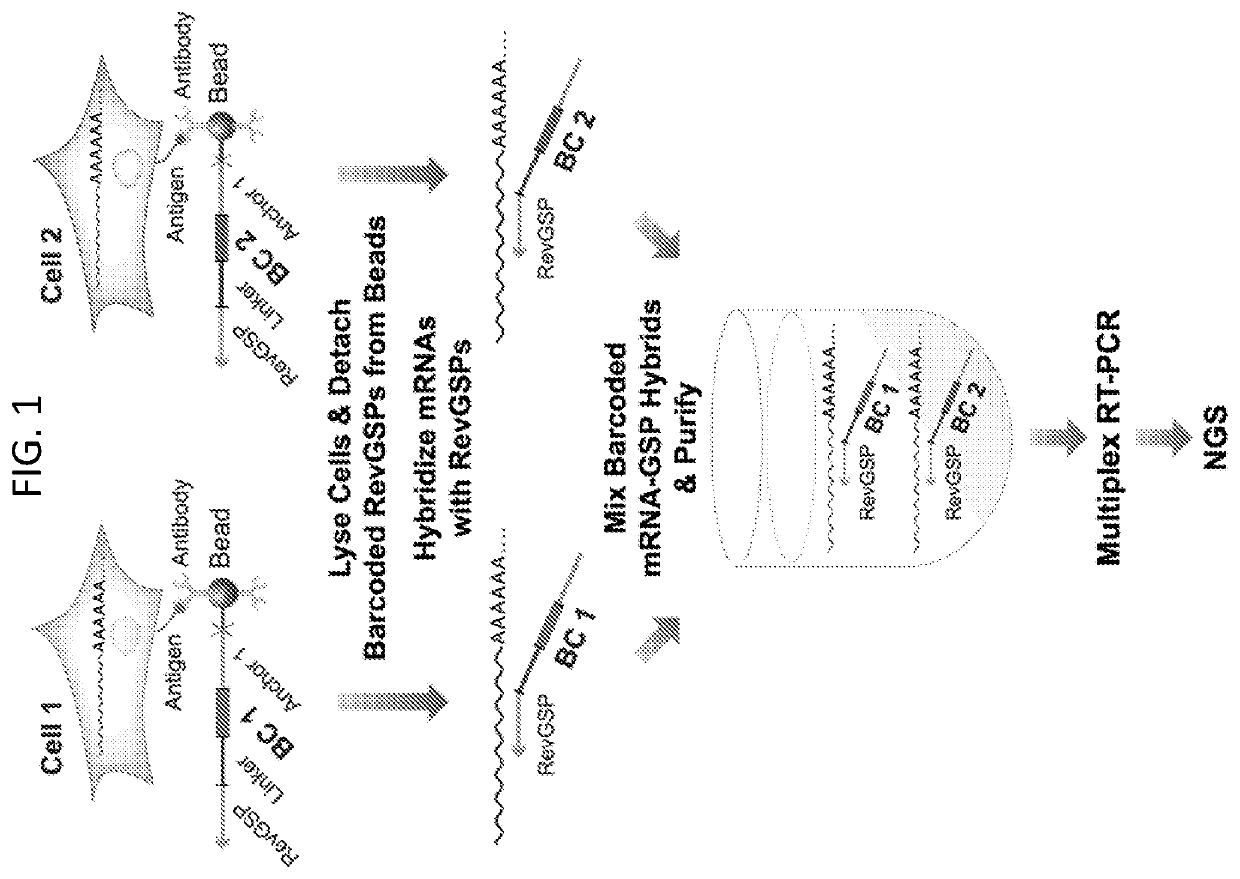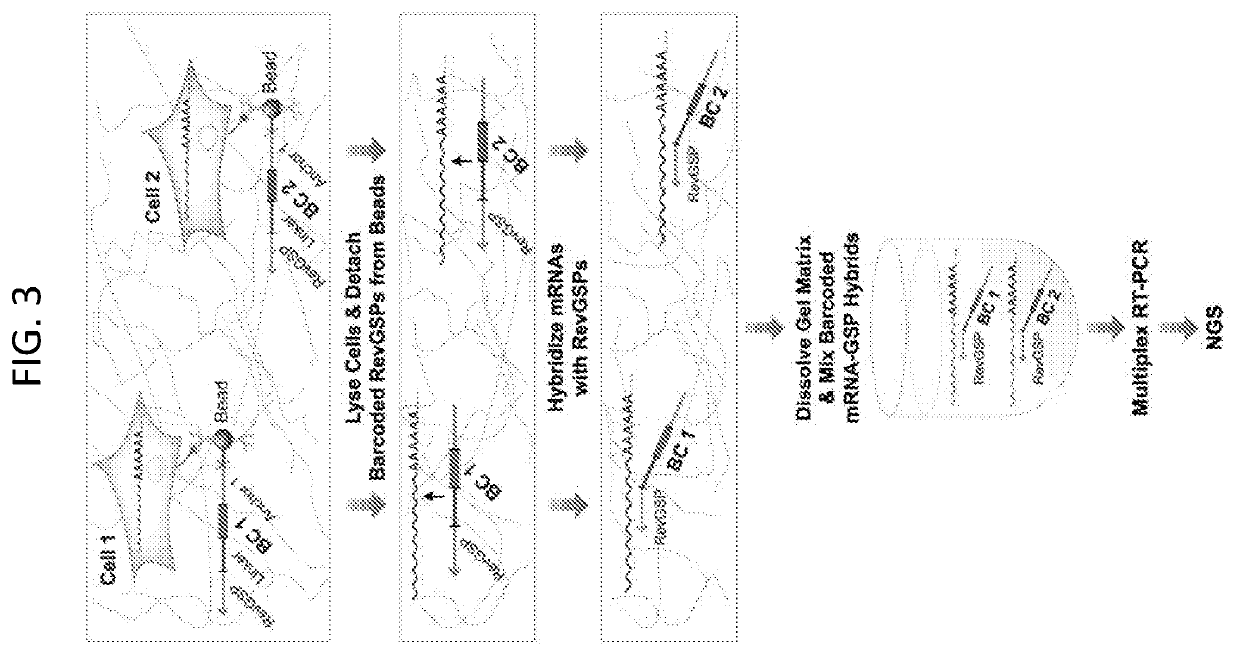Compartment-Free Single Cell Genetic Analysis
a single cell, compartment-free technology, applied in the direction of dna preparation, microbiological testing/measurement, biological apparatus and processes, etc., can solve the problems of difficult to achieve the goal, suffer from several intrinsic limitations, and the nature of pooled cell studies does not allow detailed evaluation of the fundamental biological uni
- Summary
- Abstract
- Description
- Claims
- Application Information
AI Technical Summary
Benefits of technology
Problems solved by technology
Method used
Image
Examples
example 1
for Producing Sets of Experimentally Validated Gene-Specific Primers
1A. Introduction.
[0134]Primer design is a complex and unsolved problem. To this end, as described in patent application Ser. Nos. 15 / 133,184 and 15 / 914,895 in a more detail (the disclosures of which applications are herein incorporated by reference, we describe the development of a novel in silico multiplex primer design pipeline to unambiguously access primer quality—defined here as the ability to efficiently and specifically amplify the desired template fragments in a complex reaction—on the basis of the primer sequences, target template and the reference / background genome sequence. Subsequently, we used the aforementioned resource and experimentally validated all PCR primers, resulting in multiplex PCR primers with uniform properties.
[0135]Briefly, our primer design pipeline consists of four major steps: (1) identify all primer binding-site positions among all possible DNA / RNA target template sequences; (2) evalu...
example 2
nt of Barcoded Beads with Cell Binding Moiety
[0154]To develop barcoded beads with cell binding moiety several strategies are employed. In the first approach, to chimeric oligonucleotide with structure:
L2(SEQ ID NO: 20)5′-pCCACGACCAGCCA-Moiety
is synthesized by conventional phosphoramidite chemistry and ligated to barcoded beads using the protocol described in a more detail above. Examples of cell binding moieties which are synthesized as oligonucleotide conjugates include lipids (cholesterol, fatty acid, like stearoylic or palmitic acid, oligonucleotide aptamers, e.g., CD4 aptamer with structure:
(SEQ ID NO: 21) 5′-CCACCACCGTACAATTCGCTTTCTTTTTTCATTACCTACTCTGGC-3′
[0155]In the second approach, the non-specific (e.g., against beta2-microglobulin, CD293) or cell-type specific (e.g., against CD4, CD8, CD19, etc.) antibodies are conjugated to barcoded beads through covalent or non-covalent bonds. In one protocol, the antibodies with cell binding properties are bound to beads (e.g., polysty...
example 3
n of Barcoded Bead-Cell Complexes by Binding of Barcoded Beads with Cell Sample and Enrichment for Single Cell-Single Bead Complexes in Solution
[0156]The barcoded beads with cell binding moiety are washed in 1×PBS and bind with single cells at ratio 1.5-2 / 1 in 1×PBS solution in rotating test tubes at 37° C. for 30 minutes. The single barcoded bead-cell complexes are purified from larger cell-bead complexes by filtration through cell strainer (cell sieve with 40 or 100 micron pores) or by FACS (Becton Dickenson FACS Melody) based on forward and side scattering characteristics. FACS purification allows one to separate single bead-cell complexes from targeting both multiple bead-cell complexes, empty bind beads and unbound cells. Moreover, FACS allows one to purify only one or several specific cell type-barcoded bead complexes if barcoded beads have cell-type specific binding moiety (e.g., antibodies for CD8 for T cells, or CD19 for B cells, etc.).
PUM
| Property | Measurement | Unit |
|---|---|---|
| Composition | aaaaa | aaaaa |
| Responsivity | aaaaa | aaaaa |
Abstract
Description
Claims
Application Information
 Login to view more
Login to view more - R&D Engineer
- R&D Manager
- IP Professional
- Industry Leading Data Capabilities
- Powerful AI technology
- Patent DNA Extraction
Browse by: Latest US Patents, China's latest patents, Technical Efficacy Thesaurus, Application Domain, Technology Topic.
© 2024 PatSnap. All rights reserved.Legal|Privacy policy|Modern Slavery Act Transparency Statement|Sitemap



